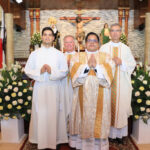Reflection by P. Jesús Villagrasa, LC, rector of the Pontifical Athenaeum Regina Apostolorum, on the post-synodal apostolic exhortation
(ZENIT – Rome).- That’s it. Pope Francis has placed in our hands the apostolic exhortation Amoris laetitia (AL), “The Joy of Love: On Love in the Family,” which gathers the fruit of the Synods held in 2014 and 2015.
A comic strip by Chiri in the weekly Alfa y Omega is being verified: “Do you see? The Pope gives us the reason? – says a man; “No way! It reaffirms our position” – says the interlocutor. “But the Pope hasn’t even started to speak” – comments a surprised Vatican prelate. “It doesn’t matter… We are training.” The debates and contrasts in the press seem unrelated to whether the Pope has said something or not. Therefore, at this moment, perhaps the most important thing is to prepare ourselves and orient ourselves toward a careful reading of this exhortation… before starting to comment on its contents. In fact, Pope Francis offers some guidance in the first seven numbers of AL.

Author’s intention… The first thing a reader and interpreter of a text seeks is the author’s intention, to know and respect it before judging the content. In our case, this intention is explicit: it does not aim to pronounce itself to resolve debated issues among theologians: “not all doctrinal, moral, or pastoral discussions need to be resolved with magisterial interventions” (AL 3). It does want to free pastors and the faithful from unacceptable extreme positions, such as “an unrestrained desire to change everything without sufficient reflection or foundation” and the pretension to “resolve everything by applying general norms or drawing excessive conclusions from some theological reflections” (AL 2). He who reads the text poorly will be someone entrenched in one of these positions, seeking phrases from the exhortation to throw as weapons at the opponent. Hans Urs von Balthasar once said that for some theologians, the Gospel had become a quarry from which to extract stones to throw in theological debates. If that happens with the Gospel… Pope Francis has wanted to gather “the contributions of the two recent Synods on the family, adding other considerations that can guide reflection, dialogue, or pastoral practice and, at the same time, offer encouragement, stimulus, and help to families in their dedication and difficulties” (AL 4). The reader’s gaze should not be directed at the positions of theologians and pastoralists, but at marriages, at the lives of families striving to live their vocation in a difficult and complex social and ecclesial context.
… and division of the text: Medieval commentators of ancient texts used to precede their commentary with a division of the text into parts and sections, usually absent in the original text. It was the safest way to grasp the author’s intention and required a deep knowledge of the entire text. The Pope saves us this fatigue and, at the same time, warns us against the “universal temptation” to go directly to pastoral guidelines that illuminate decisions to be made in very complex problematic situations, which perhaps interest the media and many people, families, and pastors most. Before reaching those topics (discussed in chapter 8), a path must be taken with stages (chapters) that have very precise purposes, which the Pope outlines in n. 6: “In the development of the text, I will begin with an opening inspired by the Holy Scriptures, which will give an appropriate tone [chapter 1]. From there, I will consider the current situation of families in order to keep our feet on the ground [chapter 2]. Then I will recall some elementary issues of the Church’s teaching on marriage and family [chapter 3], thus giving way to the two central chapters, dedicated to love [chapters 5-6]. Next, I will highlight some pastoral paths that guide us to build solid and fruitful homes according to God’s plan [chapter 6], and I will dedicate a chapter to the education of children [chapter 7]. Then I will stop at an invitation to mercy and pastoral discernment in situations that do not fully respond to what the Lord proposes to us [chapter 8], and finally I will outline brief lines of family spirituality [chapter 9].”
How to read the exhortation? “I do not recommend a hurried general reading” (7), which is the temptation of those who leaf through the text seeking novelties. The faithful have at their disposal the mature fruit of broad and rich reflection carried out by two synods and presented for the Holy Father’s consideration. An expression of theoretical and practical appreciation for this pontifical text, will be to follow these tips: first, to deepen “patiently part by part” (7), doing so with calm study and deep reflection. Second, to make this text a handbook for life, where each one seeks “what may be needed in each specific circumstance” (7).
Continuity. As with conciliar texts, perhaps someone will say that the text does not capture the spirit of some supposedly more ‘progressive’ synods or that it is not faithful to tradition… With the perspective of past years’ experience, we can paraphrase what Cardinal Ratzinger used to say about the Council. The best inheritance of the Synod is this text, rightly interpreted in continuity with the previous magisterium. Pope Francis seems to want to emphasize this through the profusion of citations of the synodal relations and those of his two predecessors: Saint John Paul II and his Familiaris consortio and Benedict XVI and his encyclical Deus Caritas Est, among other documents.
A provocation: In the presentation to the press of the apostolic exhortation, it was emphasized that Pope Francis’s language is clear, simple, concrete. I do not doubt it. But I would like the reader to be provoked by some reflections of Etienne Gilson in his work “The Philosopher and Theology,” upon the realization that philosophers rarely dared to read pontifical encyclicals that seemed difficult to them. I am convinced that Gilson’s cautions remain valid and that these texts require a very attentive reflective reading, to grasp the value of each phrase in the overall context of the exhortation, the value of some silences, and, as Gilson would say, the precision of some imprecisions. Although the reasons for the difficulty of reading are others, Gilson’s text is relevant: “The difficulty does not come from the fact that they are written in a florid chancery Latin of humanistic elegance, but rather from the fact that the sense of doctrine is not always easily grasped. Then the problem arises of translating them, and, in attempting to do so, one ends up understanding at least the reason for their style. One cannot replace the words of this pontifical Latin with others taken from any of the great modern literary languages, and even less dismantle these phrases to reassemble them differently, without immediately realizing that, however carefully it is done, the original loses its strength along the operation, and not only its strength but also its precision, which is not even the most serious. The true difficulty, well known to those who attempt the test, lies in respecting exactly what could be called, without falling into any paradox, the precision of its imprecisions. The wisely calculated precision of its voluntary imprecisions. How many times does one not think, after mature reflection, that one knows what, regarding a certain precise point, the encyclical wants to say, but it does not say it exactly, and it surely has its reasons for stopping at certain thresholds the more precise determination of a thought concerned with always remaining open, ready to welcome possible novelties.” Gilson concludes by urging Christian philosophers to, besides taking theology courses, dare to attend a pontifical university where they are taught to read pontifical documents. As rector of a pontifical university, I certainly renew that invitation, although more modestly I limit myself to inviting pastors and the faithful – to whom Amoris Laetitia is addressed – to calmly and deeply read this highly anticipated text on a vital issue for people, families, society, and the Church: “love in the family.”
—————-
To download the Pope Francis’s Post-Synodal Apostolic Exhortation, follow this link.










